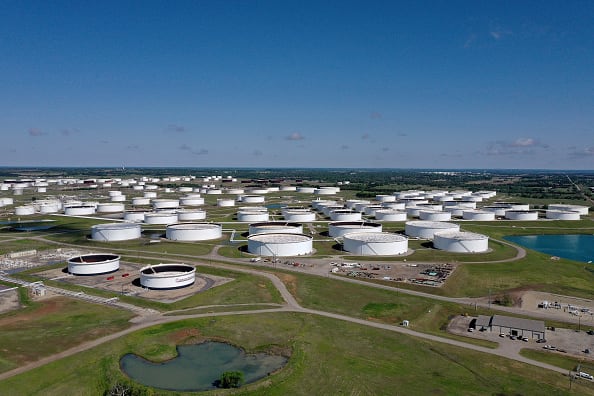Too optimistic too soon, analysts warn

[ad_1]
Oil prices rallied for five consecutive days this week amid investor optimism over the relaxing of coronavirus lockdowns in the U.S. and around the world, but several energy analysts argue it’s too soon to get carried away.
The commodity that saw one futures contract go negative for the first time ever last month, over the worst demand destruction in its history, is seeing new life as traders believe the demand trough is behind us.
But analysts stressed that the lack of storage space for crude globally remains a massive problem, and will keep a ceiling on oil prices for the near future — particularly for U.S. benchmark West Texas Intermediate.
“Front-month WTI oil futures will continue to be volatile until the storage problem is resolved and traders are confident that if their position expires they will be able to store oil at a reasonable price,” Nicholas Cawley, market economist at Dailyfx.com, wrote in a note Wednesday.
“With global economic activity unlikely to pick-up in the foreseeable future, demand for oil will remain low and the current imbalance against excessive supply will continue to cap any rally in WTI oil futures.”
An aerial drone view of a crude oil storage facility on April 23, 2020 in Cushing, Oklahoma.
Tom Pennington | Getty Images
International benchmark Brent crude was trading at $31.66 per barrel on Thursday at 8:30 a.m. ET, up 6.5%, while WTI traded up 9.5% at $26.28 per barrel. Both contracts are still very much in correction mode, down more than 50% year-to-date.
Production in the last month has finally begun to respond to the demand drop, with vast capex cuts and production shut-ins contributing to the recent recovery in prices. Oil output in the U.S. had fallen by 1 million bpd by mid-April from its record high of 13.1 million bpd just one month before.
Still, “the physical overhang does not want to go away just yet,” Citi analysts wrote Wednesday, highlighting that U.S. crude inventories grew by 6.3 million barrels this week.
And crude inventories at Cushing, the country’s key oil storage and delivery hub, registered their ninth straight weekly rise, rising above 65 million barrels.
“As much as 83% of the working storage capacity is used at the most important U.S. oil hub,” PVM Oil Associates wrote in a note Thursday. “Free capacity is a mere 13 million bbls.”
More volatility ahead
Despite urging caution for near term, however, many investors are bullish about the longer term picture.
“The nadir in COVID-19-led demand evisceration was in April at -26.1 million b/d (barrels per day), according to our models,” Ehsan Khoman, head of MENA research and strategy at MUFG bank, wrote in a note Thursday. He described a “de-synchronised recovery now underway as lockdown measures begin to ease — led by a revamping Chinese economy and convalescing transportation demand in developed markets.”
Markets will also be aided by the historic agreement reached by OPEC and its major oil producing allies —known as OPEC+ — last month to cut a combined 9.7 million bpd of production, as of May 1.
Still, Khoman warned, “oil markets remain oversupplied, and when accounting for shut-ins and voluntary OPEC+ cuts, tallies up to 6.9m b/d of surplus oil produced in May.”
That inventory overhang means there’ll be a lag in the price rally compared to equity markets, Khoman said. “In the immediate couple of weeks, we still expect significant volatility with more spikes to the downside to front-month oil prices given the sizable oversupply that has yet to be cleared.”
Rystad Energy, meanwhile, forecast on Thursday a much larger surplus of roughly 13 million bpd for May, and expects oversupply to carry over “well into June.”
“Production shut-downs have increased … but still they are not enough yet to make sure storage capacity will suffice before balance rebounds,” Rystad’s head of oil markets, Bjornar Tonhaugen, wrote.
Coronavirus uncertainty weighs on forecasts
Rystad sees a “slow market recovery coming from June as demand will indeed see a boost and most of the now unused produced oil will find more eager buyers.”
“But June is a few weeks away still,” Tonhaugen cautioned, “and till then prices have to drop further in May before the recovery.”
Goldman Sachs also sees more volatility in the immediate term, with “more spikes to the downside” in the next three to four weeks.
Any continued rallies also depend on the speed at which countries reopen their economies, and whether they see new outbreaks of the coronavirus, which could reverse any loosening of lockdowns.
MUFG sees recovery a bit sooner, expecting supply and demand to reach an “equilibrium” in late May to early June. It predicts upside risks to Brent crude forecasts of $32 per barrel and WTI at $28 per barrel by the end of the second quarter.
Looking into 2021, forecasts become more bullish. Goldman sees Brent “normalizing” to $60 per barrel in the second half of 2021.
And one particularly optimistic investor has even called a return to triple-digits for Brent, something not seen since 2014: Egyptian billionaire Naguib Sawiris told CNBC on Wednesday, “I actually believe that 18 months from now oil will hit $100.”
Source link







